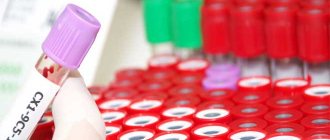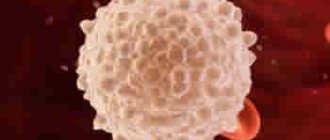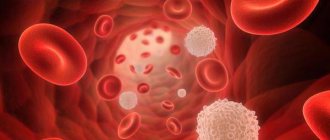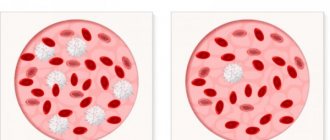0
Author of the article: Marina Dmitrievna
2017.08.20
5 550
Leukocytes
Leukocyte agranulocytes (lymphocytes) are a type of immune system cell that provides constant protection of the body from pathogenic influences of the external environment. Fight bacterial, viral, parasitic and fungal infections.
Leukocyte agranulocytes
Attention! A blood test for the leukocyte range is an important component of the general clinical examination of children and adults. Necessary for identifying pathological conditions of various etiologies and their timely treatment. Most of the leukocyte cells are located in various tissue structures and only 5% are in the blood.
Lymphocytes are elevated in a child - what does this mean and how to treat
In the results of a blood test, lymphocytes are elevated in the child, what does this mean and what to do? Now you will find out everything. Lymphocytes are a type of heterogeneous group of leukocytes, the main function of which is to protect the human body from pathogens, as well as from its own mutant cells. A pathological condition characterized by an increase in lymphocytes in a child’s blood is called lymphocytosis.
The causes of pathological lymphocytosis in children are different; they can only be determined by the attending physician, taking into account data from laboratory and instrumental examination methods, as well as the clinical picture of the disease.
Prepare for a blood test
To determine the number of Lymphocytes in the blood and the norm in children, the indicator of white blood cells is calculated based on the results of a clinical analysis, which is taken from the phalanx of the ring finger, or from the heel in infants.
The laboratory technician counts 2 indicators: the number of white cells and their percentage in the total mass of leukocytes.
Before taking the test, you should not eat for about 8 hours; for infants, the fasting time is 2 hours. Do not give your child fried or salty foods 2 days before donating blood.
Do not take the pills in the morning until the laboratory technician takes your blood for analysis. If drug treatment is carried out, then the best option is to donate blood 2 weeks after the end of drug treatment.
On the eve of the test, avoid physical activity and nervous stress. Children of 2 years have enough patience to endure the morning hungry, but the norm of lymphocytes in the blood will be calculated with absolute accuracy.
Healthy children undergo tests at an annual preventive examination, children with chronic pathology - 2 times a year.
Blood is taken for analysis several times:
- during long-term therapy of any disease with complications;
- when making a diagnosis;
- when checking the success of treatment.
The importance of lymphocytes is to perform immune functions. Each time the doctor “reads” the analysis results, compares the data obtained with previous results, with standard indicators, and draws a conclusion about the child’s condition.
The role of lymphocytes in the body
Lymphocytes play a leading role in human immunity, since they are capable of implementing both types: cellular and humoral. Cellular immunity is ensured through the biosynthesis of special protein molecules - antibodies, which have a high degree of affinity for foreign antigens. After the formation of a stable antigen-antibody complex, the process of reproduction of pathogenic species of microorganisms is stopped or the toxic substances released by them are neutralized.
A distinctive feature of cellular immunity is its implementation through direct interaction with foreign cells (without the participation of antibodies and the complement system). The main target is microorganisms that were not destroyed during phagocytosis, as well as cancer cells.
Classification
According to modern classification, this type of cells is divided based on functional characteristics:
- B lymphocytes (10–20% of the total number of lymphocytes) in children are synthesized by liver cells and bone marrow. After interaction with foreign antigens, they are able to actively synthesize antibodies and also act as antigen-presenting cells. The reasons for a significant increase in this type of cells in a child’s blood may be allergic reactions or autoimmune pathologies;
- Cytotoxic T lymphocytes perform the function of dissolving the body's own cells that have been infected with intracellular parasites or have undergone mutation. They are of particular importance for viral diseases and oncological pathologies;
- NK cells are a major component of human innate antitumor immunity. A distinctive feature is the ability to destroy cells that are inaccessible to T lymphocytes. They show activity during infection with HIV and papillomavirus, as well as during oncology.
What are lymphocytes and what functions do they perform?
Lymphocytes are cells of the immune system that provide uninterrupted protection of the human body from pathogenic factors of various etiologies. When a foreign microorganism or foreign particle penetrates, activation and increased production of lymphocytes in organs occurs. Most of the leukocyte agranulocytes in children are produced in the thymus, and in adults - in the bone marrow.
Depending on the type of leukocyte agranulocytes, their main functional features differ. In general, they are responsible for acquired immunity. There are three main types of lymphocytes: B, T and NK (natural killer) cells.
An important type of leukocyte agranulocytes is considered to be B-lymphocytes, which synthesize peptide compounds - immunoglobulins. Another name for immunoglobulins is antibodies. They bind to pathogenic microorganisms and prevent their normal reproduction and the release of toxic substances. The content of B cells in the peripheral bloodstream does not exceed 7-19%.
A common type of leukocyte agranulocytes (up to 70% in the peripheral bloodstream) are T lymphocytes. Cytotoxic lymphocytes form the basic cellular and humoral immune response. This group of leukocyte cells includes:
- T-killers,
- T-suppressors,
- T-helpers.
Natural killer cells recognize and kill infected cells before infection begins. Their content in the bloodstream varies over a wide range: from 5 to 20%. An insufficient number of NK cells leads to cancer. In the absence of natural killer cells, the body cannot recognize cancer cells in a timely manner.
The normal level of lymphocytes in a child
Only a specialist can interpret the results of a blood test and establish a final diagnosis. Self-diagnosis with subsequent selection of treatment methods is unacceptable, since it poses a threat to the life and health of the child. Standard (reference) values were selected for children of different ages, which must be taken into account when interpreting the results obtained.
It was noted that lymphocytes in the blood are maximally increased in a child under the age of 1 year. This condition is necessary to ensure the most complete protection of the baby from infection against the background of inadequately developed other immune mechanisms. A variant of the norm is considered to be that the criterion under consideration is in the range from 45 to 75% of the total number of leukocytes.
Starting from the second year, the baby’s lymphocyte level gradually decreases. At the age of 2 to 4 years, the norm is from 35 to 60%, and from 4 to 8 years: 30 to 50% of the total leukocytes.
Reference values for a child aged 8 to 10 years are 30-45%. And during the puberty period (up to 16 years) from 30 to 45% of the total leukocyte content. For patients over 16 years of age, the standard values are 19-37%.
The norm of lymphocytes in a blood test
Activated lymphocytes are called “mature” leukocyte agranulocytes. The number of such cells increases when a foreign body or harmful microorganism penetrates the child’s body. Elevated activated lymphocytes in a child’s blood test indicate a pathological process - viral, bacterial, parasitic or fungal.
Depending on the age of the child, normal indicators of the total content of lymphocytes in the bloodstream differ:
- Newborns – from 14 to 32%.
- From one week to one month – from 21 to 48%.
- From one to 6 months – from 42 to 67%.
- Up to one year – 40-62%.
- From 1 to 3 years – 32-34%.
- Up to 5 years – 30-52%.
- Up to 13 years – 27-48%.
Important! Any deviations in the content of leukocyte agranulocytes indicate the presence of diseases. You should not self-diagnose or treat your child. Interpretation of the results of immunophenotyping tests or general blood tests is carried out by a qualified specialist.
If activated lymphocytes are increased in the blood, it is lymphocytosis, and if they are decreased, it is lymphocytopenia. Both conditions pose a threat to the child's health. It is necessary to carry out additional diagnostic measures to identify the cause of an increase or decrease in the number of leukocyte agranulocytes in the bloodstream.
What does this mean if a child has elevated lymphocytes?
It should be understood that a slight (up to 5%) increase in lymphocytes in a child’s blood is not a reason for panic and can be triggered by improper preparation of the subject for the delivery of biomaterial or daily fluctuations in laboratory criteria.
It has been noted that often in a child, along with lymphocytes, monocytes in the blood also increase. This condition is typical for the acute stage of infection of bacterial origin (tuberculosis), viral infections and oncology. Along with monocytes and lymphocytes, the child’s ESR (erythrocyte sedimentation rate) also rises. However, all parameters should return to normal limits with effective treatment.
Depending on the severity of lymphocytosis, absolute and relative are distinguished.
Relative lymphocytosis
The causes of relative lymphocytosis (increased content of lymphocytes in the blood of a child up to 55-70%) include:
- children under 2 years of age;
- acute stage of a viral disease;
- dysfunction of the thyroid gland, accompanied by excessive synthesis of hormones T3 and T4;
- hypocortisolism - suppression of the functions of the adrenal cortex, as a result, the production of the hormone cortisol is suppressed. Its main functions are participation in the regulation of carbohydrate metabolism and the formation of a stress response in the human body. Often the disease is accompanied by a sharp decrease in weight and appetite, blood sugar concentration, depressive behavior, depression, rapid heartbeat, tremors of the limbs, etc. If parents notice such symptoms, they should immediately consult a doctor;
- splenomegaly – enlargement of the spleen due to autoimmune or infectious diseases, as well as with anemia of various types. The maximum severity of pathology is observed in leukemia;
- infection with the bacteria Salmonella typhi, resulting in the development of typhoid fever. It is characterized by a typical clinical picture with an increase in body temperature to critical, general weakness. As well as roseola skin rash and damage to the lymphatic system of the lower intestinal tract.
Why do lymphocytes increase in a child’s blood?
Lymphocytosis is a pathological condition in which the total content of leukocyte agranulocytes is greatly increased. Lymphocytosis in children or adults occurs due to viral, bacterial, parasitic or fungal infectious pathogens.
Symptoms of lymphocytosis vary from person to person. In some, it is manifested by fever, chills, hyperhidrosis of the extremities or dizziness, and in some it is asymptomatic. In some cases, this condition occurs due to psycho-emotional or physical stress and does not pose a threat to the health of children or adults.
Elevated lymphocytes are diagnosed using a biochemical blood test. There are absolute and relative lymphocytosis. Absolute lymphocytosis occurs in severe disorders - leukemia, for example. A relative increase in leukocyte agranulocytes is observed during viral, fungal or inflammatory reactions. An increased number of lymphocytes in the blood is not an independent disorder, but a sign indicating pathology.
Common causes of lymphocytosis in children:
- Infectious diseases (smallpox, herpes zoster, measles, malaria, viral liver damage.
- Allergy.
- Ulcerative colitis.
- Bronchial asthma.
- Anemia (hemolytic, iron deficiency).
- Endocrine system disorders.
- Leukemia (with acute or chronic course).
- Thymic hyperplasia.
- Somatoform autonomic dysfunction.
- Bone marrow hyperfunction.
For a long time after the child’s recovery, an increased level of leukocyte agranulocytes is observed. In most cases, lymphocytosis of this etiology does not pose a danger to the baby’s health. Treatment of lymphocytosis is aimed at eliminating the underlying disease. Folk remedies, dietary supplements or over-the-counter medications can worsen the course of the underlying disease.
How to reduce a child’s lymphocytes at home?
A lot of lymphocytes in a child’s blood indicates a serious illness that should not be attempted to be treated on your own. The doctor prescribes a comprehensive examination to determine a specific diagnosis and the exact cause that caused the increase in lymphocytes in the child’s blood.
If a bacterial infection is detected, an antibiogram test is performed to determine the class of the most effective antibacterial drugs. It is important to consider the age of the baby, since this factor is a limitation when choosing a medicine. When prescribing therapy for very young patients, preference is given to bacteriophages, which selectively destroy exclusively pathogenic strains of bacteria.
For the treatment of viral diseases, drugs are selected whose mechanism of action, on the one hand, is aimed at inhibiting the vital activity of the pathogen. On the other hand, it helps to activate the natural defenses of the child’s body.
Summary
To summarize, important points should be highlighted:
- elevated lymphocytes in a child’s blood can occur against the background of infectious diseases, parasitic infestations, as well as with pathologies of the bone marrow or spleen;
- Only the attending physician has the right to determine the cause of the increase in lymphocytes in the blood of a child. The fundamental importance of this rule is due to the need for a competent approach to treatment. And a high risk of complications when delaying the selection of adequate methods of therapy;
- the rules for preparing for analysis are similar for general clinical research methods: blood is donated on an empty stomach, infants are not fed 2-3 hours before the biomaterial is donated. In addition, you should give your child plenty of clean water without gas;
- a one-time minor deviation from the norm may be caused by improper preparation for the analysis. A repeat study is scheduled after 3-5 days.
Certified specialist, in 2014 she graduated with honors from the Orenburg State University with a degree in microbiologist. Graduate of the graduate school of the Federal State Budgetary Educational Institution of Higher Education Orenburg State Agrarian University.
In 2020 At the Institute of Cellular and Intracellular Symbiosis of the Ural Branch of the Russian Academy of Sciences, she completed advanced training in the additional professional program “Bacteriology”.
Laureate of the All-Russian competition for the best scientific work in the “Biological Sciences” category 2020.
Conditions promoting lymphocytosis
Sometimes an increased level of lymphocytes in the blood occurs after stressful conditions in a child whose psyche is not strong enough in relation to nervous overload.
Also, some diseases can cause lymphocytosis:
- endocrine pathologies;
- anemia;
- viral infectious diseases;
- bacterial infections of the body;
- protozoal infections;
- cancer and precancerous conditions;
- rheumatoid arthritis.
Indeed, lymphocytes in the blood are elevated due to endocrine diseases. Some of them are of autoimmune origin. This may occur when the thyroid or pancreas is damaged by leukocyte cells.
Anemic conditions cause an increased level of lymphocytes due to changes in the composition of the blood with extensive loss and abnormalities in the production of its cellular composition.
The introduction of pathogens of viral and bacterial pathology into the cells of the body are the reasons that cause an increase in lymphocytes in the blood of a child.
An increased level also indicates other pathologies in the body.
The development of protozoal infections in a child’s body also gives a signal to the immune system, and it reacts in such a way that lymphocytes in the blood increase to destroy these microorganisms.
Summer is the time when the excess of lymphocytes is less common than at other times of the year.
Oncological diseases in children, as in adults, cause a lot of complications in all systems and organs. Because of this, the cellular composition of the blood also changes, and increased lymphocytes in the blood are observed.
A child has elevated lymphocytes in the blood: causes of elevated lymphocytes
“Your child has elevated lymphocytes”! This phrase from a doctor always causes a lot of concern among parents. Some of them immediately make an appointment with specialists and rush to undergo additional laboratory tests. Others begin searching for all kinds of information on medical forums, consulting with relatives and friends, which ends in attacks on pharmacies.
Leukocytes are knights in white armor.
White blood cell - lymphocyte
All white bodies that are part of the complex chemical composition of the blood and are responsible for human immunity are called leukocytes. Leukocytes are divided into 5 subtypes, each of which performs a specific function:
- Neutrophils - attack viral cells, absorb them and dissolve them in themselves. The same is done with dead cells, removing all the “garbage”. By coping with the bacteria, they die themselves.
- Eosinophils originate in the bone marrow and move into the blood within a few days. A few hours later, they penetrate those human organs that come into contact with the external environment (gastrointestinal tract, lungs, skin). They fight infection and help the body with allergic reactions. Like neutrophils, they die in the fight against foreign cells.
- Basophils are responsible for blood clotting, support immunity, and block the spread of microbial migration throughout the body.
- Monocytes actually perform the same functions as other white blood cells. But monocytes are distinguished by their ability to cope with harmful bacteria in conditions of increased acidity.
- Lymphocytes - produce antibodies to foreign cells, destroy harmful bodies, control and regulate the composition of other cells. Lymphocytes, unlike other white bodies, do not die when confronted with an enemy. They continue to perform their functions, providing not short-term, but long-term care for human immunity.
Each of the listed categories at a certain moment can change its own norm in one direction or another. Thus, a reduced number of lymphocytes is called lymphopenia, an increased number is called lymphocytosis.
Briefly about lymphocytes
This is the name given to representatives of leukocytes, which are protective cells of the immune system. They are formed in the bone marrow and perform the function of recognizing and destroying foreign antigens that enter the body.
All lymphocytes in the blood are divided into the following types:
- T lymphocytes. They perform the function of recognizing antigens. They are 85% of the total.
- B lymphocytes. The mission of this species is antigen presenting.
- NK lymphocytes that destroy viral and tumor cells.
You should know that lymphocyte counts change with the child’s age. The norms are determined as a percentage of leukocytes. And in the first days after the baby’s birth, their figure is up to 25% of the total number of leukocytes, by the 7th day it is 40-42%, from the age of six - 45-65%. And after six years, the norm of lymphocytes is 25-40%.
What is childhood lymphocytosis
This is what is called an excess of lymphocytes in the blood. Lymphocytosis can be reactive (reflects the immune response to an external stimulus) and malignant. The second is an independent leukocyte disease, for example, leukemia. Absolute and relative types of lymphocytosis are also classified. The latter is characterized by an increase in the percentage of lymphocytes in the blood. An absolute increase in the number of lymphocytes is characteristic.
The causes of an absolute increase in lymphocytes are the following: Crohn's disease, lymphocytic leukemia, autoimmune diseases, bone marrow metastases, infectious mononucleosis.
What values are considered elevated in children?
Increased lymphocytes - a physiological phenomenon in early childhood
Of all the leukocytes in a child’s blood, lymphocytes are the most common. From birth to two years, its indicators are quite high, then they begin to decrease - these are physiological processes of a child’s development, and they do not require medical intervention.
It’s another matter if an increase in lymphocytes provoked the disease. It must be said that an increase in the level of lymphocytes in a child’s blood, in most cases, is temporary, and they immediately return to normal after successful treatment of all kinds of colds, inflammations and other ailments that every person periodically faces.
Lymphocytes and their types
Reactive lymphocytosis in children is caused by viral infections. Also, malignant forms of manifestation of this increase in cells indicate the development of blood cancer and the development of leukocytosis.
Lymphocytosis in children is a reason to visit a doctor - a hematologist or oncologist (the pediatrician must give a referral for additional examination and consultation).
It is also important to determine the causes of the child’s disorder, for this:
- lymph nodes and internal organs are examined;
- the condition of the bone marrow is determined;
- The presence of an infectious agent in the body is checked.
The protective cells of the human body (lymphocytes) are part of the immune system and are formed in the red bone marrow. They perform the function of recognizing foreign agents that fall within their field of action. Then they penetrate these antigens and destroy them, this process is natural.
The age of the child matters for the normal indicators of some cellular elements. The level of lymphocytes in the blood changes as the child grows. Therefore, the norm, if considered as a percentage for a newly born baby, will be about 25% of the total leukocyte composition of the blood. From the age of one week to six years, the figure will be 45-65%, then lymphocytes decrease in the process of growing up, by the age of 18 it will be 25-45%.
These white blood cells come in several varieties.
The recognition function of processed antigens is performed by T lymphocytes.
They make up 85% and are divided:
- Helper T cells help strengthen the immune system response and make killer T cells active;
- T-killers destroy damaged cells of their own body by various parasitic forms;
- T-effector cells, formed from the two types of T-cells listed above, maintain a tolerant attitude towards their body and prevent the development of autoimmune changes;
- Suppressor T cells regulate immune response.
There are also B lymphocytes that are capable of transforming into plasma cells to produce antibodies. NK lymphocytes represent a group of natural killers for the destruction of tumor cells and those affected by viral infection.
What is lymphocytosis, classification
The child's body is constantly exposed to the environment and this impact can be negative in the form of infections or diseases. The immune system of a healthy child is able to easily resist such diseases. This happens by increasing or decreasing components in the blood. These components include leukocytes.
They are the ones who fight foreign cells that have entered the body. During the development of the disease, the number of leukocytes increases, which allows you to quickly and efficiently overcome the infection in the body. Lymphocytosis is an excess of lymphocytes in the blood above a certain level.
There are 2 types of lymphocytosis:
Absolute lymphocytosis indicates that the number of lymphocytes per liter of blood is exceeded. Accompanied by:
Relative lymphocytosis indicates a constant number of cells in the blood . This type of pathology is much more common in practice. A deviation of this type indicates that the patient is in the recovery stage or has recently had an infectious disease. If an excess number of bodies is detected in the tests, it is worth remembering recently suffered illnesses or paying attention to the presence of symptoms of an incipient disease.
A relative increase in bodies in the blood is normal only in children under 2 years of age. The norm for a teenager is considered to be no higher than 37%.
Causes of elevated lymphocyte levels
Prolonged physical activity or emotional stress can provoke an increase in the level of blood cells.
If the number of lymphocytes in the blood has reached the maximum level, this indicates serious adult diseases, such as:
- Infectious mononucleosis;
- tuberculosis;
- sarcoma;
- cytomegalovirus.
Also, the causes of the development of lymphocytosis include viral diseases or pathological processes occurring in the body.
There are a number of causes of lymphocytosis in children, these include:
- blood transfusion;
- avitaminosis;
- HIV infection;
- taking certain medications;
- prolonged exposure to the sun;
- poor nutrition.
In most children, after recovery , lymphocytes may remain elevated for several months . There is no need to worry about this because it is normal. Their levels will gradually decrease to normal levels.
Malignant lymphocytosis
The child's body is constantly exposed to the environment and this impact can be negative in the form of infections or diseases. The immune system of a healthy child is able to easily resist such diseases. This happens by increasing or decreasing components in the blood. These components include leukocytes.
They are the ones who fight foreign cells that have entered the body. During the development of the disease, the number of leukocytes increases, which allows you to quickly and efficiently overcome the infection in the body. Lymphocytosis is an excess of lymphocytes in the blood above a certain level.
There are 2 types of lymphocytosis:
- Absolute;
- Relative.
An increase in leukocytes in the blood is a sign of infectious diseases
- viral lesions;
- whooping cough;
- hepatitis virus;
- infectious mononucleosis;
- tuberculosis;
- disruption of the thyroid gland;
- the presence of a malignant tumor in the body;
- toxoplasma infection.
Relative lymphocytosis indicates a constant number of cells in the blood. This type of pathology is much more common in practice. A deviation of this type indicates that the patient is in the recovery stage or has recently had an infectious disease. If an excess number of bodies is detected in the tests, it is worth remembering recently suffered illnesses or paying attention to the presence of symptoms of an incipient disease.
Relative lymphocytosis in children most often does not require treatment, it shows the normal functioning of the immune system during the spread of the virus. Absolute - in most cases, indicates a developing pathology and must be treated in a timely manner.
A relative increase in bodies in the blood is normal only in children under 2 years of age. The norm for a teenager is considered to be no higher than 37%.
Prolonged physical activity or emotional stress can provoke an increase in the level of blood cells.
If the number of lymphocytes in the blood has reached the maximum level, this indicates serious adult diseases, such as:
- Infectious mononucleosis;
- tuberculosis;
- sarcoma;
- cytomegalovirus.
Also, the causes of the development of lymphocytosis include viral diseases or pathological processes occurring in the body.
There are a number of causes of lymphocytosis in children, these include:
- blood transfusion;
- avitaminosis;
- HIV infection;
- taking certain medications;
- prolonged exposure to the sun;
- poor nutrition.
An increase in lymphocytes is a sign of the disease, because a child’s body needs an increased number of white blood cells to fight the virus.
In most children, after recovery, lymphocytes may remain elevated for several months. There is no need to worry about this because it is normal. Their levels will gradually decrease to normal levels.
In malignant lymphocytosis, the level of absolute lymphocyte count is increased. A common symptom of malignant lymphocytosis is enlarged lymph nodes, accompanied by anorexia, weakness, weight loss, fever over 38 0C, and severe night sweats.
This dangerous disease is rare. The incidence of malignant lymphocytosis is less than 4 cases per 100,000 children. Diseases in this group are treatable, especially if detected early.
Malignant lymphocytosis, which is more often diagnosed in children, includes:
- lymphoblastic leukemia;
- Hodgkin's disease;
- non-Hodgkin's lymphomas are extremely rare in childhood.
The level of lymphocytes in acute lymphoblastic leukemia is 3 times higher than the age norm for children. This type of oncology is the most common malignant disease in children.
Pathology occurs due to the loss of the ability of lymphocyte precursors (lymphoblasts) to mature. As a result, the cells of this population divide uncontrollably and their concentration increases.
Depending on which lymphocyte lines are affected, T- or B-lymphoblastic leukemia develops. If the number of line B lymphoblasts in the population is increased, this means that the child will have increased B lymphocytes in the blood and will develop B lymphoblastic leukemia.
This disease most often affects boys aged 1-6 years. The risk of B-lymphoblastic leukemia is increased at 3 years, and at 15 years - T-lymphoblastic leukemia.
Lymphogranulomatosis
Increased lymphocytes are found in the blood of a child with lymphogranulomatosis, a malignant disease that occurs more often in adolescents, and is not observed in children under one year of age. Lymphogranulomatosis or Hodgkin's disease manifests itself with symptoms similar to ARVI, accompanied by enlarged lymph nodes in the neck.
In addition to affecting the cervical lymph nodes, the virus actively invades the intrathoracic nodes, causing the patient to cough and have difficulty breathing. The prognosis of the disease with early treatment is favorable.
Non-Hodgkin's lymphomas are a group of diseases in which malignant damage to the lymphatic system occurs. Lymphomas are characterized by higher than normal levels of lymphocytes in the blood and the ability to spread throughout the body, which means that a child can develop a tumor anywhere in the body.
The risk of this disease is increased at 5–9 years of age. In children under one year of age, non-Hodgkin lymphomas are practically not detected.
The tumor has been widespread since its appearance, which is why it progresses very quickly. However, in recent years, in the treatment of these diseases, it has been possible to achieve 75–95% relapse-free survival, thanks to the use of polychemotherapy - treatment with several antitumor drugs.
How to recognize a disease in a child
There are no obvious signs of lymphocytosis . Basically, the disease is diagnosed when a person takes a blood test prescribed by a pediatrician. An exception is infectious diseases, as they have their own list of symptoms. These include weakness, lethargy, rash, cough, sore throat, runny nose, fever, chills.
If absolute lymphocytosis develops, this is a likely sign of a tissue tumor. In this case, the patient will feel pain in the bones and constant fever. The liver and spleen increase in size. The body is more often exposed to infectious diseases due to reduced immunity against the background of damage to the body by the virus.
Cartoon about the work of cells of the immune system - lymphocytes and their role in the development of oncology. The information is presented in an accessible form that even children can understand.
What is the difference between childhood lymphocytosis and adult lymphocytosis?
The difference between children's and adult lymphocyte norms is the number of blood cells. In children under 10 years of age, a slightly elevated lymphocyte count is normal. While in an adult this will already be considered a sign of concern.
The average rate of cells in a baby’s blood ranges from 40 to 70%. Therefore, if an adult sees a high indicator in a child’s tests, he should not draw independent conclusions, but should consult with a pediatrician. In most cases there is no reason to panic.
Symptoms of childhood lymphocytosis
If the disease occurs as a result of a viral disease, then the baby develops symptoms such as weakness, fever, restless sleep, lack of appetite, and the appearance of a rash. Due to the increased load on the liver, spleen and lymph nodes, they increase in size.
One of the symptoms of lymphocytosis is enlarged lymph nodes. Normal size – no more than 1 cm
An important sign of the manifestation of the disease is that the body temperature can rise to critical levels, and antipyretics will not help.
Infants are able to announce illness by crying, whims and elevated body temperature, even convulsions (read more here). Difficulty and heavy breathing may also occur.
In addition to lymphocytes, the blood contains neutrophils. This group of cells is aimed at fighting viral infections. Neutropenia and lymphocytosis may occur simultaneously.
Non-infectious causes
Due to the fact that the function of lymphocytes is primarily aimed at protecting the body from various infections and parasites, an increased content of these cells is observed in children with certain diseases. These include:
- Acute respiratory viral infections.
- Viral type hepatitis.
- Adenoviral infections.
- Measles, mumps, rubella.
- Flu, sore throat.
- Infection caused by herpes viruses.
- Infectious mononucleosis.
- AIDS virus.
- Toxoplasmosis.
- Infection with enteroviruses.
- Helminths.
- Tuberculosis of all types.
- Acute or chronic course of leukemia.
A strong excess of these protective cells is observed in Smith's disease, a rare pathology accompanied by lymphocytosis. Another reason is Franklin's disease, characterized by increased formation of immunoglobulins and proliferation of lymphoid tissue.
Low or high lymphocytes are often the result of non-infectious causes. These include:
- Intoxication of the body with various chemicals, such as carbon disulfide, lead.
- Diseases that are autoimmune in nature.
- Pathologies of the thyroid gland.
- Bronchial asthma.
- Vitamin deficiency.
- An operation to remove the spleen, as a result of which blood cells are not synthesized in the required quantity.
- Long-term use of certain medications.
We must also not forget that after suffering a particular disease, the level of lymphocytes may remain above normal for some time, while other blood elements, on the contrary, are reduced.
Many lymphocytes are found in the leukocyte blood count of a child after injury, treatment with antibiotics or hormonal drugs.
The level of this population of immune system cells is increased:
- for autoimmune disorders;
- bronchial asthma;
- anemia;
- vitamin deficiency;
- dystrophy.
In rare cases, lymphocytes in a child's blood may be elevated as a result of preventive vaccination against measles and rubella.
Diagnostic methods
To diagnose a decrease in blood cells, the patient does not need to undergo various examinations and undergo numerous tests. But it will not be possible to make such a diagnosis externally. To do this you need to take a blood test. With this data, the doctor is able to identify abnormalities.
An increase in white bodies in the baby’s blood in combination with other symptoms indicates the presence of a disease. A general analysis or biochemical blood test is performed to identify the disease.
There are more detailed examination methods. They include:
- bone marrow examination;
- immune system research;
- identification of the type of infection.
If necessary, lymphocytosis can be diagnosed using additional procedures:
- Ultrasound;
- chest x-ray;
- CT scan.
To exclude suspicion of a cancerous tumor, the patient undergoes immunophenotyping. If a patient experiences enlargement of certain organs, oncologists are involved in treatment.
Treatment: which doctor should I contact?
Initially, the baby is examined by a pediatrician. After detecting an increased level of lymphocytes in the blood and excluding recent viral diseases, the doctor refers the child to a hematologist. In order to make a correct diagnosis, additional studies may be prescribed.
If the level of lymphocytes has not returned to normal within a couple of months after the illness and there is an increase in the lymph nodes, liver and spleen, then a referral to an oncologist is given. You should not immediately give in to panic, as they will mostly refer you to the necessary consultation.
Lymphocytosis is not treated because An increased level of lymphocytes is an indicator of other diseases . If the elevated level of white blood cells is associated with an infectious disease, then it is treated directly.
Antiviral drugs, anti-inflammatory or antibacterial drugs are used to treat the infection. If the disease becomes more complicated and bacterial infections appear, antibiotics are prescribed.
After successful recovery, lymphocytes return to normal after some time. It is recommended to provide the baby with sufficient rest, proper balanced nutrition, and walks in the fresh air. How to organize the first walks for a newborn in winter is described in this article.
If the deviation turns out to be more deplorable, chemotherapy is used. In the worst cases, a bone marrow transplant is possible. The child is provided with bed rest and contact with other people is minimized.
During treatment, vitamin therapy, anti-allergenic drugs and mandatory bed rest .
Features of treatment
Initially, the baby is examined by a pediatrician. After detecting an increased level of lymphocytes in the blood and excluding recent viral diseases, the doctor refers the child to a hematologist. In order to make a correct diagnosis, additional studies may be prescribed.
If the level of lymphocytes has not returned to normal within a couple of months after the illness and there is an increase in the lymph nodes, liver and spleen, then a referral to an oncologist is given. You should not immediately give in to panic, as they will mostly refer you to the necessary consultation.
Lymphocytosis is not treated because An increased level of lymphocytes is an indicator of other diseases. If the elevated level of white blood cells is associated with an infectious disease, then it is treated directly.
Antiviral drugs, anti-inflammatory or antibacterial drugs are used to treat the infection. If the disease becomes more complicated and bacterial infections appear, antibiotics are prescribed.
After successful recovery, lymphocytes return to normal after some time. It is recommended to provide the baby with sufficient rest, proper balanced nutrition, and walks in the fresh air. How to organize the first walks for a newborn in winter is described in this article.
If the deviation turns out to be more deplorable, chemotherapy is used. In the worst cases, a bone marrow transplant is possible. The child is provided with bed rest and contact with other people is minimized.
During treatment, vitamin therapy, anti-allergenic drugs and mandatory bed rest may be prescribed.
If you notice symptoms that may indicate lymphocytosis, you should not panic and make a diagnosis yourself. It is important to consult a specialist and follow all his instructions.
Therapy is carried out depending on what disease provoked the child’s blood composition disorder and the increased number of protective cells. In most cases, a change in the cellular composition of the blood indicates a viral infection occurring in the body. In this case, no treatment aimed at reducing lymphocytes in the blood is required.
It is enough for the patient to organize bed rest, quality sleep, a healthy diet, as well as symptomatic therapy. When the temperature rises, antipyretics are used. If there is a sore throat, painkillers are prescribed. For coughs, mucolytics and expectorants are used.
If the infectious disease is caused by bacteria, the patient needs to take antibacterial agents. They can only be prescribed by a specialist, since these medications have a fairly strong effect. It is important to remember that even with ordinary ARVI, children under 6 years of age must be observed by a pediatrician. Self-medication may not produce results and cause serious complications.
Expert opinion
Ksenia Dunaeva
User experience expert and comment moderator. Higher medical education and more than 5 years of actual practice.
Ask Ksenia
If lymphocytosis was caused by a neoplasm, the child needs to stay in the hospital to determine the shape of the tumor, its activity and type. The patient is advised to remain in bed and limit communication with other people. Such patients are prescribed treatment in the form of chemotherapy or surgery for a bone marrow transplant.
Life after illness
The consequences of the disease include, firstly, complications from infectious diseases. Secondly, it can trigger the spread of a benign or malignant tumor, which will lead to more serious complications.
After the lymphocyte level returns to normal, the patient does not feel any discomfort, given that the cause of the illness was a viral infection.
After treatment there are no special contraindications and the child continues to live an active life. The only point remains is that parents should think about strengthening their baby’s immunity in order to prevent the occurrence of viral diseases.
Prevention
The reason for the malfunction in the level of lymphocytes lies in the child’s immune system. To protect your baby from the return of the disease, it is important to exclude some moments from the baby’s life:
- frequent stress;
- poor nutrition;
- strong physical activity;
- lack of alleys in the fresh air;
- infection of a young body;
- long exposure to the hot sun.
Don’t forget about preventive appointments with doctors. Even if there are no symptoms, it is better to prevent the development of the disease at its inception.
When lymphocyte levels are elevated
Newly born babies do not have very many lymphocytes because their immune system is not yet fully functioning. But already a few days after birth, the number of lymphocytes begins to increase and up to 4 years of age exceeds the number of other types of leukocytes.
At approximately 4-5 years, the level of lymphocytes and neutrophils becomes equal, after which the number of neutrophils begins to predominate.
The upper limit of normal lymphocytes in children is considered to be:
In a newborn baby
From the 5th day of life
From 10 days to a year
For children 1-5 years old
In children over 5 years old
In children over 10 years old
If the test result shows an increased number of lymphocytes exceeding the indicated numbers, this is called lymphocytosis . It can be relative if the number of lymphocytes does not exceed the norm, but only seems to be too high due to a decrease in the level of other leukocytes. In this case, the total number of leukocytes may remain normal or be increased.
Absolute lymphocytosis , caused by an excess of lymphocytes in the peripheral bloodstream due to their active production in the bone marrow and other sites or insufficient destruction in the spleen, also occurs
Lymphocytes in the blood of children: normal
Unfortunately, as practice shows, not even all pediatricians are aware that elevated lymphocytes in children under one year and the first years of life are the norm. The reason for this is the immaturity of the child’s immune system at birth. It continues its development for several years, and all this time lymphocytes predominate among other leukocytes, but they are gradually replaced by other cells.
Thus, in the first days of life, the relative norm of lymphocytes for newborns is up to 25%, and by the end of the first year it increases noticeably. By the age of 4, this figure remains at its maximum – 50-65%. Then the percentage of lymphocytes in children begins to decrease: closer to 6 years - to 42%, after 10 years it drops sharply, and by adulthood it “catches up” with the norm for adults - 37-40%.
The development of lymphocytosis is indicated when the number of lymphocyte cells exceeds generally accepted age norms:
- in 1 year - 65%;
- at 5 years - 55%;
- at 10 years - 45%.
In addition, another important factor should be taken into account. In “old-style” laboratories, calculations are carried out “manually,” but in modern laboratories, blood is analyzed automatically using technology: in the latter case, not only the number of lymphocytes is counted, but also their characteristics are determined: shape, degree of maturity, and others.
Depending on the method of analysis, the results are provided in different dimensions, and the norms of such analyzes may vary. Therefore, when comparing the results obtained with age norms, it is always necessary to pay attention to the units in which the data are indicated.
Causes of lymphocytosis
Diseases that cause elevated levels of lymphocytes in the blood of children include:
- ARVI.
- Viral hepatitis.
- Measles.
- Infection caused by adenovirus.
- Chicken pox.
- Rubella.
- Flu.
- Herpes infection.
- Toxoplasmosis.
- HIV infection.
- Infectious mononucleosis.
- Enterovirus infection.
- Whooping cough.
- Infection with cytomegalovirus.
- Brucellosis.
- Infection with parasites or protozoa.
- Tuberculosis.
- Leukemia, which can be either acute or chronic lymphocytic leukemia.
- Malignant thymoma.
- Non-Hodgkin's lymphoma.
- Smith's disease is a rare infectious disease with lymphocytosis.
- Franklin's disease. This is the name of another rare pathology in which lymphoid tissue grows and the production of immunoglobulins increases.
However, a high percentage of lymphocytes is not always associated with a viral infection or tumor process. If lymphocytosis is relative, the reason for this blood test result is factors that reduce the number of other types of leukocytes, for example, neutropenia due to vitamin B12 deficiency or the use of certain drugs that inhibit neutrophils.
Non-infectious causes of lymphocytosis also include:
- Poisoning with arsenic or lead, as well as carbon disulfide or tetrachloroethane.
- Autoimmune diseases.
- Hyperthyroidism.
- Bronchial asthma.
- Avitaminosis.
- Removal of the spleen, as a result of which blood cells cannot be utilized in the required volume.
- The effect of certain medications - medications against epilepsy, hormonal medications, antibiotics, narcotic analgesics and others.
Separately, it should be noted that after recovery, the level of lymphocytes does not immediately return to normal levels. In most children, lymphocytes will be detected in increased numbers for several weeks and sometimes months after the illness has ended, but their levels will gradually decrease.
How is an elevated level of lymphocytes in the blood treated?
Therapy for lymphocytosis depends on the underlying disease. For viral diseases, non-steroidal anti-inflammatory drugs, vitamin complexes, plenty of fluids and constant rest are prescribed. The child’s body will cope with viral diseases on its own. It is not recommended to use antiviral drugs, as they have no effect on the child’s body. Their effectiveness is comparable to placebo. Some medications of this type have side effects that can significantly affect your child's health.
For bacterial infections, antibacterial drugs are prescribed. If a child has a high body temperature, acetylsalicylic acid is indicated. It is extremely undesirable for children to use paracetamol due to its hepatotoxic properties.
In oncological diseases, the main emphasis is on eliminating tumors. After recovery, the level of lymphocytes is restored to its original values.











